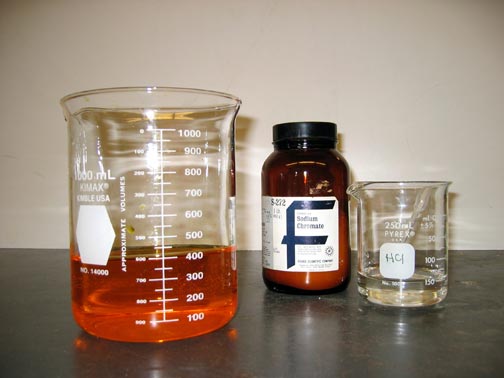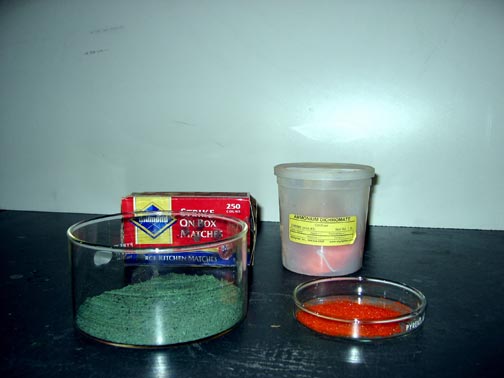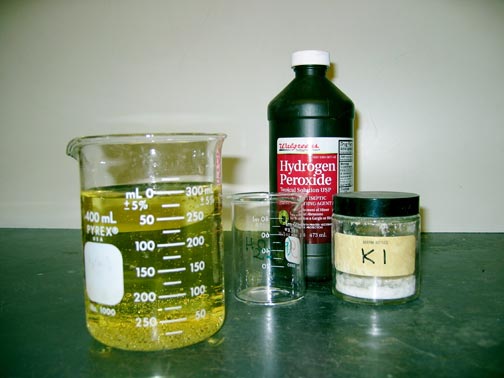Ingredients: potassium iodide, hydrogen peroxide
Procedure: A complete recipe follows.
1. Prepare a concentrated solution of potassium iodide in a beaker.
2. Add hydrogen peroxide and observe reaction.
Understanding:
In this reaction, the clear and colorless liquids, aqueous solutions of potassium iodide and hydrogen peroxide, are mixed to create a clear liquid with a brownish tint.
The product of this reaction is molecular iodine.
KI(aq) + H2O2(aq) → I2(aq)
We would like to determine the overall balanced equation for this reaction.
The "zeroth step" is to recognize what, if anything, undergoes a change in oxidation state as part of the reaction. We assign oxidation states
+1 -1 +1 -1 0
KI(aq) + H2O2(aq) → I2(aq)
and recognize that the iodine is being oxidized and the oxygen is being reduced.
Suppose we try to balance this reaction as a whole. We might multiply the KI by a factor of 2, since we know we need two iodine atoms to make the diiodine product. And we might add water as a product, to balance the oxygen. But now the hydrogen is out of sorts. What do we do from there?
In balancing the chemical equations for dissolution/precipitation reactions, and acid/base reactions, we impose the fundamental principles of the conservation of elements and the conservation of charge. In doing so, we arrive at a balanced equation that defines the overall transformation of reactants to products. The resulting stoichiometric ratios are uniquely determined by respecting the conservation of the elements and the conservation of charge.
In balancing the chemical equations for reduction/oxidation reactions, the situation is different. We will often find it very difficult to balance the chemical equation for the overall reaction combining the oxidation and reduction events. We find that we need to separate the reduction and oxidation events and separately balance the half-reactions describing the chemistry of the distinct reduction and oxidation events. Those half-reactions must satisfy the two fundamental principles of the conservation of the elements and the conservation of charge. They are then combined to form the balanced equation for the overall chemical reaction.
Let's start with the reduction of oxygen in hydrogen peroxide.
The first step is to balance all atoms other than hydrogen and oxygen
H2O2 → H2O
The second step is to balance the oxygen using water
H2O2 → 2 H2O
The third step is to balance the hydrogen using hydrogen ions or protons
2H+ + H2O2 → 2 H2O
At this point, we have satisfied the conservation of the elements. As the fourth step, we impose the conservation of charge by adding electrons such that the total charge on each side of the equation is equal
2e- + 2H+ + H2O2 → 2 H2O
Now let's apply the same series of steps in balancing the oxidation of iodine. The steps might seem like "overkill" in this case, but let's follow them all the same.
1st step: balance all atoms other than H or O
2 I- → I2
2nd step: balance oxygen using water
2 I- → I2
3rd step: balance hydrogen using protons
2 I- → I2
4th step: balance charge using electrons
2 I- → I2 + 2e-
Each of the half-reactions are balanced and satisfy the fundamental principles of the conservation of the elements and the conservation of charge. Now we can add the two half-reactions together to derive the overall balanced equation
2H+(aq) + 2 I- + H2O2(aq) → 2 H2O(l) + I2(aq)
Note that the addition of the two half-reactions is done such that the total number of electrons appearing as reactants in the reduction reaction is equal to the total number of electrons appearing as products in the oxidation reaction. No electrons appear explicitly in the overall balanced equation, although we now know the number of electrons that are transferred in the overall reduction/oxidation reaction.
Now suppose that we wanted to know the chemistry of the reduction/oxidation reaction in a basic solution. Do we have to start from scratch? Not at all! We can simply titrate our final overall reaction with base.
We add two hydroxide ions to the reactants so as to neutralize the acidic protons. To maintain atomic and charge balance, we also add two hydroxide ions to the products. The result is
2 OH-(aq) + 2H+(aq) + 2 I- + H2O2(aq) → 2 H2O(l) + I2(aq) + 2 OH-(aq)
If we combine the acidic protons and basic hydroxide ions, we create water as a reactant
2 H2O(l) + 2 I- + H2O2(aq) → 2 H2O(l) + I2(aq) + 2 OH-(aq)
which cancels the water as a product leaving the final result
2 I- + H2O2(aq) → I2(aq) + 2 OH-(aq)
for the chemistry of our reaction in a basic solution.
 A clear solution is transformed from yellow to orange upon the addition of acid.
A clear solution is transformed from yellow to orange upon the addition of acid.
Ingredients: sodium chromate, hydrochloric acid
Procedure: A complete recipe follows.
1. Prepare a concentrated solution of sodium chromate.
2. Prepare a dilute solution of hydrochloric acid.
3. Add the acid to the sodium chromate solution and observe the reaction.
Understanding:
The transformation of yellow aqueous chromate ion into bright orange aqueous dichromate ion is quite dramatic and reversible, as the pH of the solution is varied.
This looks like a simple reaction to balance
NaCrO4(aq) → Na2Cr2O7(aq)
We can start with the first step and multiply the chromate by a factor of two, to balance the chromium. The second step would be to add water to balance the oxygen. And then... wait a second! We forgot the zeroth step of identifying what is oxidized and what is reduced. Let's assign oxidation states
+1 +6 -2 +1 +6 -2
Na2CrO4(aq) → Na2Cr2O7(aq)
Good thing that we observed the zeroth step. This is not a reduction/oxidation reaction at all! It is a rearrangement of atoms to form two distinct chromium(VI) oxides, but not one that involves a change in the oxidation state of chromium or any other participating element.
 A pile of orange crystals is ignited, leading to a tower of sparks and a tower of billowing, deep green "soot."
A pile of orange crystals is ignited, leading to a tower of sparks and a tower of billowing, deep green "soot."
Ingredients: ammonium dichromate, matches
Procedure: A complete recipe follows.
1. Place a pile of orange ammonium dichromate crystals in a dish.
2. Heat the crystals with matches until reaction begins.
Understanding:
The dramatic reaction of dry and bright orange ammonium dichromate crystals, accompanied by sparks and rising hot gases, leads to the formation of a fluffy and dull green chromium(III) oxide product. To determine the overall chemistry of this reaction, we begin with the zeroth step of assigning oxidation states to all of the atoms in our reaction
-3 +1 +6 -2 +3 -2
(NH4)2Cr2O7(s) → Cr2O3(s)
We note that the chromium is reduced, from a +6 to +3 oxidation state. But what is oxidized? We need to know a bit more about this reaction. We noted in the reaction that a plume of green chromium(III) oxide rose above the reaction, carried on a current of gas that is a product of the reaction. What is that gas? Observing our reaction, we note that the ammonium ions might be the source of the gas, which could be ammonia or molecular nitrogen. There was no smell of ammonia in the reaction, so it must be that the product gas is dinitrogen.
So we can expand on our reaction equation to add
-3 +1 +6 -2 +3 -2 0
(NH4)2Cr2O7(s) → Cr2O3(s) + N2(g)
where the nitrogen is oxidized, from the -3 to 0 oxidation state.
We are now in a position to balance our half-reactions, starting with the oxidation of nitrogen
1st step: balance all atoms other than H or O
2 NH4+ → N2
2nd step: balance oxygen using water
2 NH4+ → N2
3rd step: balance hydrogen using protons
2 NH4+ → N2 + 8 H+
4th step: balance charge using electrons
2 NH4+ → N2 + 8 H+ + 6 e-
followed by the reduction of chromium
1st step: balance all atoms other than H or O
Cr2O72- → Cr2O3
2nd step: balance oxygen using water
Cr2O72- → Cr2O3 + 4 H2O
3rd step: balance hydrogen using protons
8 H+ + Cr2O72- → Cr2O3 + 4 H2O
4th step: balance charge using electrons
6 e- + 8 H+ + Cr2O72- → Cr2O3 + 4 H2O
We can add the two half-reactions together to determine the overall chemical reaction for the "dichromate volcano"
(NH4)2Cr2O7(s) → Cr2O3(s) + N2(g) + H2O(g)
The plume of hot gas rising above the reaction is a mixture of nitrogen and water vapor. These examples demonstrate the ease and power of the half-reaction method.
Balancing redox reactions
Question:
Consider the common combustion reaction of methane with dioxygen. Balance the half-reactions for oxidation and reduction for the reaction occurring in aqueous solution.
Based on your half-reactions, design an electrochemical cell that could be used to carry out the chemistry of the combustion of methane, while capturing the driving force of that reaction as electrical potential.
You can check your answers here.
 A clear solution is transformed from yellow to orange upon the addition of acid.
A clear solution is transformed from yellow to orange upon the addition of acid.
 A pile of orange crystals is ignited, leading to a tower of sparks and a tower of billowing, deep green "soot."
A pile of orange crystals is ignited, leading to a tower of sparks and a tower of billowing, deep green "soot."
 Two clear liquids are mixed, leading to a solution with a brown tint.
Two clear liquids are mixed, leading to a solution with a brown tint.